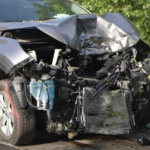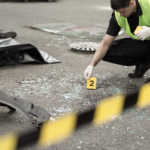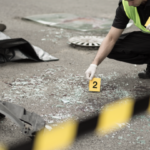Road Rage: Prevalence, Causes, Consequences and Potential Criminal Offences

This article will discuss what causes road rage particularly the psychological and psychiatric aspects followed by contributing factors to this violent and potentially murderous phenomenon.
From there we shall refer to the prevalence of road rage citing predominantly such events in the U.S and Australia.
It will then cover the statistics of motor vehicle accidents highlighting the fact that we shall never know how many may have died or been seriously injured as the result of road rage. Also spoken about is the Australian government’s national road safety action plan all the way to 2030 and examples of white papers to reduce the prevalence of road rage.
Nearing the end of this article we shall take a look at the state of Texas’ initiative of a dedicated road rage taskforce designed to catch the perpetrators in the act and by doing so gathering material first hand which is then assessed by the psychologists attached to this successful initiative.
Causes of road rage
Road rage is regarded by the psychological & psychiatric community as a disorder and in some cases is caused by elevated levels of stress and frustration leading to anger which manifests itself in verbal or physical episodes of violence.
In other instances, road ragers may involve drivers who have borderline personality or antisocial personality disorders and whilst it is not a stand-alone crime involves a raft of serious charges including predatory and menacing driving offences resulting in significant periods of imprisonment, fines and vehicle sanctions.
It may also constitute the criminal offences of assault and bodily harm.
Road rage is committed by basically two opposing types of drivers, one being the speeding risk taking aggressive driver and the safer driver who takes offence to the risk posed and indicates displeasure of such behaviour by a simple gesture of anger or frustration for example a wave of the hand and alternatively verbal or physical assault.
Of course, the offending motorist may respond with similar gestures of anger or frustration and verbal or physical assault. Not all victims however retaliate. So in essence it is not only the initial offending behaviour which precipitates a road rage incident. It can be either driver or indeed the occupants of either vehicle.
Other contributary factors
In addition to the description of offenders outlined above are those drivers simply having a stressful day underscored by the general stress associated with modern urban living. Alcohol and illicit drugs are often factors which lead to road rage, although it can also be through dangerous driving at times.
Further factors attached to events of road rage are serious mental illnesses, anxiety and depression. Borderline personality disorder (BPD) is characterised as unexplained intense anger, impulsive behaviour and transient paranoid ideation (paranoid thoughts believing you are threatened in some way) manifesting in a fight or flight response. Psychiatric morbidity is another example which impairs private functioning.
Driver fatigue and defective vehicles may also play a part in causing a road rage incident with another less discussed but significant contributing factor being that of each year there are more cars on the road with more drivers endeavouring to get to their destinations in a timely manner on highways and freeways that have not been redeveloped at the rate necessary to cope with such an increase in traffic.
The prevalence of road rage
Let’s start with the USA where 2022 studies by and for the National Highway Traffic Safety Administration (NHTSA) and the American Automobile Association (AAA) estimate that approximately 8 out of 10 drivers have admitted aggressive or dangerous driving at some stage of their motoring careers.
Whilst there are many claims as to when road rage was first pronounced as a violent occurrence, from the media in general to a local Los Angeles news station after a number of shootings on several city freeways.
However it appears to have surfaced in the summer of 1987 in Southern California though some claim it came about decades earlier and that the only difference was now they have guns. Others say it was in the mid-1990s.
Whilst road rage behaviour and some forms of aggressive driving are two separate offences one being criminal and the other a traffic offence it is abundantly clear that aggressive driving in many instances leads to road rage and more serious criminal offending. It is also clear that you don’t have to be driving aggressively to be involved in a road rage incident. You could be driving sedately and for a split second be inadvertently distracted attracting the ire of a fellow motorist.
Statistics of road rage
Many various road traffic organisations in the U.S. including Octo telematics (OCTO) which provides telematics & data analytical solutions to the worldwide automotive insurance industry and the American automobile association (AAA) appear to agree that:
- Between 54% & 66% of traffic fatalities are caused by dangerous driving.
- 37% of those involve a firearm.
- Other weapons include hammers, knives and iron bars amongst many others including the vehicle itself
- 50% on the receiving end of road rage confess to retaliating.
- One 7-year study statistic reported that road rage was the cause of 218 murders over this period and in excess of 12000 motorists or passengers injured. Included in this statistic were motorists running each other off the road. The American Automobile Association (AAA) suggest that this equates to a statistic of road rage causing 30 deaths and 1800 motorists or passengers injured annually although the injured statistic appears somewhat high.
- 78% of drivers confess to at least one episode of dangerous driving in the past year.
- The age of most road rage perpetrators was between 25 to 39 years.
U.S road rage deaths by shooting
U.S. road rage shootings is a growing problem with in excess of 500 American residents shot in such incidents in 2022 which averages out to one person fatally shot or injured every 16 hours over the course of the year.
With a trend in some U.S. states tending to weaken gun laws motorists and passengers are more vulnerable to road rage shootings with 141 Americans killed in road rage incidents and 413 injured by gunshot in 2022.
Brad Bushman a communications professor at Ohio state university said that research has shown that having a gun in the car has a psychological effect of increasing aggressive driving as it makes people feel more powerful. Ryan Martin a psychology professor at the university of Wisconsin-Green Bay intimated that if guns weren’t present more lives would be saved and less serious injuries inflicted.
Australian road rage
A recent Australian study on road rage from ‘Compare the Market’ organisation confirms that approximately two thirds of all Australian adults (12.7 million) have been subjected to at least one incident of road rage in Australia.
New South Wales (NSW) motorists are one of the good guys, meaning the more patient and less aggressive drivers due to its road rage percentage being below the Australian national average at 57.3%, along with the winning Australian Capital Territory (ACT) at 47.1%.
This is an improvement in NSW road ethics as it was only just over a year ago that it was reported that road rage was all too common in this southeastern Australian state.
Whilst Queensland is known as the sunshine state it is regarded as the road rage capital of Australia with 67.7% of drivers involved in such road rage incidents followed by Victoria and Western Australia at 66% & 64.8% respectively. In between all of them is Tasmania at 52.4% and South Australia at 58.6%.
Whilst the facts speak for themselves the Twitter feed reverses some of the positions as it appears that the most stressed drivers vent their spleen by tweeting.
The National Roads and Motorists Association (NRMA) in a NSW & ACT road rage and courteous driving survey found that in excess of 25% of road rage incidents involved a child who was present and traumatised by the event.
Several examples of NSW road rage deaths and assaults
February 2022 was when it was reported that two NSW bikie related accused cold case road rage killers had been extradited to Queensland to face murder accessory charges from 2009.
February of this year also saw a truckie face Parramatta local court charged with causing the death of a taxi driver with his truck in a road rage incident on Sydney’s north shore in 2021. The matter was adjourned until 20 September 2023.
The same year a man was arrested and charged with murder after a road rage incident at South West Rocks in NSW north coast.
In 2022 Irish Olympian Anthony Lally who took part in the 1980 Moscow Olympics cycling road race pleaded guilty to a road rage incident where he physically and verbally assaulted a female driver on Pittwater road in Sydney indicating misogynistic traits.
This month a cyclist was caught on camera smashing the window of a Sydney bus with a chain in a road rage incident.
Again April this year saw up to 8 road ragers sought by NSW police after an attack on 3 people in Bankstown Sydney in a road rage episode where the two vehicles were involved in a collision on 3 separate occasions.
Australia road accident deaths
For the 12 months from March 2022 to 2023 there have been 1204 road users die by virtue of road accidents which includes in excess of 70 children.
At least it is thought by accident however in many instances it is unknown if some occurred by virtue of road rage with the breakdown of those who perished leaving behind thousands more who will grieve.
How many times have we read of fatal motor vehicle accidents where it was reported that the road was clear and that driving conditions were excellent declaring the reason for crashing in many instances inexplicable?
There were 690 single car accidents and 432 multiple vehicle crashes involving fatalities.
- 557 drivers
- 189 passengers
- 163 pedestrians
- 246 motorcyclists
- 40 cyclists
The breakdown of each state is as follows.
- NSW 289
- VIC 259
- QLD 281
- SA 93
- WA 180
- TAS 48
- NT 37
- ACT 17
These figures vary by 9 according to the Bureau of Infrastructure and Transport Research Economics (BITRE) Australian road deaths database (ARDD) 14 March 2023 and the Australian Automobile Association (AAA) due to perhaps a variable of some weeks from February to March 2023 as per other corresponding reports outlining each state’s fatalities. Another reason for minor changes in statistics include those who died within 30 days of the accident whilst in hospital though does not include deaths from crashes that are the result of suicide or from natural causes.
Another 17 Australian holiday makers died over the Easter long weekend which includes four adults who crashed in the NSW tablelands. A motorcyclist who collided with a car on Waterfall Way perished after being struck by a vehicle on Good Friday with a male pedestrian dying after being struck by a car in Tamworth. This was despite in excess of 18000 traffic infringement notices having been issued across the nation.
March 2023 saw 107 road deaths alone with 34 of these being in NSW.
The cause of Australian motor vehicle accidents
Approximately 64% of Australian motorists have been involved in at least 1 motor car accident with the attributable cause of around 50% of drivers having been tailgating. In a Budget Direct 2021 comprehensive study the causes were found to be the result of
- Speeding
- Distraction
- Aggressive driving (including tailgating)
- Alcohol and drug affected
- Fatigue
- Failing to give way
- Driving through red traffic lights
- Poorly designed roads (including intersections)
It is interesting that the survey indicates that the respondents do not appear to acknowledge the aspect of speeding is in fact aggressive driving.
In addition to the number of fatalities on Australian roads each year there are about 40,000 who are seriously injured according to the national road safety strategy an Australian government initiative.
National road safety action plan 2023 – 25
This action plan is another phase in the National road safety strategy (NRSS) 2021 – 30 and beyond bringing all Australian federal, state and territory governments together to reduce road trauma on Australian roads including road rage.
The end game is to reduce all such road trauma in its entirety by the year 2050 which is practically impossible but can go a long way to reducing deaths and serious injuries on Australian roads significantly.
The primary goal is to reduce fatalities by 50% and serious injuries by 30% by the year 2030.
From perusing 16 fact sheets of this plan it seems to be rather unwieldy to be capable to function as a fit for purpose mechanism in particular to address the issues associated with the specifics of road rage in all its forms and perhaps needs a commissioner to coordinate what is an otherwise worthy initiative.
Australian and U.S. studies crying out for better road rage data
Despite a parliamentary inquiry in 2005, a national criminology research council white paper on the subject of road rage in 2011 and a white paper by Monash university accident research centre less than 6 months ago (late 2022) there have been no discerning efforts to ensure road rage is illustrated alongside any and all associated charges emanating from the actual road rage incident.
This is essential as will be indicated by Dr Amanda Stephens a senior research fellow at Monash university accident research centre and professor Art Markman of the university of Texas who believe that road rage is a phenomenon which can be solved.
Dr Stephens with the support of the Australian Capital Territory (ACT) road safety fund developed the RAD program which stands for reduce aggressive driving which was tested over the past 6 months and proved to be highly successful in reducing road rage significantly. Further trials are continuing with Dr Stephens and her team designing, developing and implementing behaviour modification programs to support drivers in managing all the aspects concerning road rage traits.
The question must surely be, how does Dr Stephens intend motorists to take advantage of what seems to be a successful pilot program?
Should the subject form part of a driving test for new motorists and for those who already have a licence, should they participate in an information questionnaire of sorts to acknowledge their participation? It will certainly be a logistical problem of quite some magnitude.
Alternatively, and perhaps by necessity, there needs to be a clear mechanism for such programs to become part of the national road safety action plan and from the available information this does not appear to be the case as yet.
Road rage is not a standalone offence, but the conduct can amount to a crime
There are many traffic offences for which those who engage in road rage may be liable for, including negligent driving, reckless driving and the more serious offence of dangerous driving – each of which are made up of different ‘essential element’, or ingredients.
The crimes of offensive language and conduct, and even assault offences may also apply.
This means there is little need to enact a discrete offence for the conduct – in fact, such an offence could prove difficult or even impossible to formulate given the breadth of conduct that comes under the banner of road rage.
However, the fact there is no such standalone offence means it is difficult to collate accurate data on the prevalence of the conduct, although anyone who has driven a motor vehicle for years will know it is widespread and common.
The Texas initiative
Psychology professor Art Markman of the university of Texas suggests with better data on specifically the offence of road rage, stakeholders can better assess the underlying causes and create appropriate solutions to reduce or eradicate it. Such as the RAD program devised by Australia’s Dr Stephens.
North Texas law enforcement agencies from many cities got together and with the support of the Texas department of safety formed a dedicated road rage North Texas aggressive driving taskforce. In unmarked cars it gave out 333 citations and 36 warning citations. The taskforce surreptitiously swarmed the highways and apprehended the offenders as road rage occurred. The goal is twofold with the taskforce able to properly identify precisely what occurred and with the psychological community devise strategies such as the RAD program to reduce this crime. Secondly word would get out that there is a road rage taskforce looking for offenders which in itself is a deterrent.
Dallas police force itself had investigated 17 homicides as a result of road rage incidents in 2021 and had the taskforce been operating at that time are convinced that those offences could have been avoided. Whilst Australia does not have the same gun problems, any form of assault which could be avoided is important.
Perhaps there is a lesson for Australian police forces to undertake dedicated road rage taskforces in all states and territories.
Number of Australian registered vehicles
There are close to 21 million motor vehicles currently registered in Australia according to the Australian governments department of infrastructure transport regional development communications and the arts (BITRE) which replaced the Australian Bureau of Statistics motor vehicle census which was discontinued in 2021.
There are close to 100,000 electric vehicles registered in Australia of which about 79% are battery electric whilst 21% are plug-in hybrid versions.
An interesting fact is that there are in excess of another 4.5 million road-using vehicles not included in the total number of registered motor vehicles. These include agricultural tractors – all terrain vehicles – caravans – forklifts and golf buggies.






